ARTS / CULTURE & LEISURE
Tang Dynasty tea set discovered in N.China’s Shanxi
An all-in-one Tang Dynasty (618-907) ceramic tea set has recently been discovered at the Qujiazhuang Cemetery Ruins in North China's Shanxi Province. The discovery shows China's tea culture has existed for more than 1,000 years.
Revealed by the Shanxi Academy of Archaeology on Saturday, the tea set was unearthed from Tomb M20 at the ruins. Around six individual pieces made of white and green ceramic were discovered - a ceramic tea pot, tea bowl, cup, measuring spoon, residue bucket and crusher.
Xue Qunjun, a Chinese tea historian, told the Global Times that the discovery shows how tea culture was embedded in Tang people's lives as a "daily ritual."
"The tea cup discovered is also known as cha ou. It was a typical Tang Dynasty tea ware decorated with the period's iconic flower-petal designs. Tang people's exquisite tea tasting tradition also reflects the good social and cultural ambiance back then," Xue noted.
The expert also noted that "tea art" has continued in China for more than 4,000 years. It showcases the nation's "cultural spirit and elegant character."
In 2022, the Chinese spirit embedded in tea making was listed as a world intangible cultural heritage by UNESCO.
Liao Ping, a specialist in Tang Dynasty archaeology, told the Global Times that it was very rare for such a complete tea set to be discovered, adding that it can shed light on the tomb owner's social background.
A total of 30 tombs dating from the Tang Dynasty to the Qing Dynasty (1644-1911) have been excavated from the Qujiazhuang Cemetery Ruins.
Tomb M1 held many pottery treasures. There were 16 arched niches around the tomb walls near the floor of the tomb. These niches held mud figurines, such as "civil officials."
"The unearthed figurines are like a window that looks onto the inner world of the tomb owner," Wu Junhua, the lead archaeologist of the Qujiazhuang Cemetery Ruins project, told the media.
"All these discoveries shed light on Tang Dynasty burial culture, and also ancient Chinese lifestyles, like tea culture," Liao noted.
Revealed by the Shanxi Academy of Archaeology on Saturday, the tea set was unearthed from Tomb M20 at the ruins. Around six individual pieces made of white and green ceramic were discovered - a ceramic tea pot, tea bowl, cup, measuring spoon, residue bucket and crusher.
Xue Qunjun, a Chinese tea historian, told the Global Times that the discovery shows how tea culture was embedded in Tang people's lives as a "daily ritual."
"The tea cup discovered is also known as cha ou. It was a typical Tang Dynasty tea ware decorated with the period's iconic flower-petal designs. Tang people's exquisite tea tasting tradition also reflects the good social and cultural ambiance back then," Xue noted.
The expert also noted that "tea art" has continued in China for more than 4,000 years. It showcases the nation's "cultural spirit and elegant character."
In 2022, the Chinese spirit embedded in tea making was listed as a world intangible cultural heritage by UNESCO.
Liao Ping, a specialist in Tang Dynasty archaeology, told the Global Times that it was very rare for such a complete tea set to be discovered, adding that it can shed light on the tomb owner's social background.
A total of 30 tombs dating from the Tang Dynasty to the Qing Dynasty (1644-1911) have been excavated from the Qujiazhuang Cemetery Ruins.
Tomb M1 held many pottery treasures. There were 16 arched niches around the tomb walls near the floor of the tomb. These niches held mud figurines, such as "civil officials."
"The unearthed figurines are like a window that looks onto the inner world of the tomb owner," Wu Junhua, the lead archaeologist of the Qujiazhuang Cemetery Ruins project, told the media.
"All these discoveries shed light on Tang Dynasty burial culture, and also ancient Chinese lifestyles, like tea culture," Liao noted.



